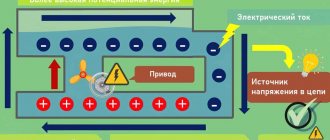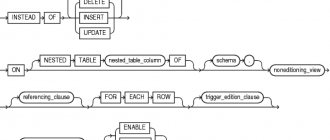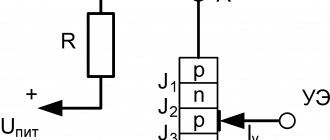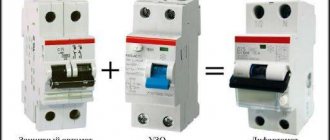For many people, the words difavtomat and RCD mean nothing. But the time comes to replace the electrical wiring in the house or the construction of a summer house begins, and experts constantly mention them, the need for protection against electric shock, and offer different options. This is where the home owner needs to make a choice, and the right one.
He wants to get reliable protection against electric current for reasonable money, without overpayment and unnecessary equipment. To do this, you need to understand a little about the devices, their purpose, differences, advantages and disadvantages. It will be useful for any novice electrician to understand what the difference is between different RCDs.
How to distinguish an RCD, a difavtomat and a circuit breaker by purpose: the most important principle
All three protective modules have approximately the same appearance, dimensions, and method of mounting on a Din rail. This is the result of equipment unification. They are united by the common principle that they control the current parameters and are designed to save a person and his property from its effects.
However, they perform different tasks. I will explain them briefly in three paragraphs.
Electric current in a home network moves in a closed circuit in the direction that a person gave it when connecting a household appliance to the voltage circuits. In this case, useful work is done.
The magnitude of the current depends on the resistance applied to the voltage and must be maintained at the nominal value and not go beyond the designated area of the electrical circuit. In this case, any device works normally.
But in our lives there are many unforeseen accidents, when a person makes a mistake or the insulation is damaged, its resistance decreases. In this case, the current flows in another direction or increases to a dangerous value, which requires emergency measures.
This task is performed by security modules using their own algorithms.
How a residual current device works: a brief explanation
The RCD is designed to control the direction of current flow according to the circuit intended for it. It cuts off the voltage from the area being stripped if a leak forms through damaged insulation.
The residual current device is mounted and connected in the apartment panel.
In simple words: if a person accidentally touches the phase potential and an electric current flows through his body, then the RCD is obliged to prevent the emergency situation that has arisen as quickly as possible and save the victim.
For this purpose, it includes a phase comparison organ - a differential transformer. It constantly monitors the vectors of currents flowing along the input phase wire and the outgoing zero wire.
If the circuit insulation is normal, then there will be no leakage to the side, and both vectors will be balanced. The RCD allows the circuit to continue to operate normally.
As soon as the differential transformer detects an imbalance of vectors, the voltage is immediately turned off.
Due to this principle, the RCD is officially called a “Differential Switch”. Remember this term well. This module does not perform any other functions other than combating leaks, and if the current increases above the rated value, it can burn out; it itself needs such protection.
Circuit breaker: module protective functions
The machine is also mounted at the input of the circuit in the panel. It controls the amount, not the direction, of current flowing through it. When it begins to exceed the nominal value, the circuit is broken by a power contact.
The value of the emergency current can be either small or very dangerous. At values up to 1.13 rated load the machine does not work. Such regimes are created for a short time and usually disappear on their own.
The switchable overload zone starts from this boundary and consists of two sections:
- thermal release;
- electromagnetic cut-off.
The speed of eliminating an emergency situation, as shown by the time-current characteristic, depends on the magnitude of the overload. The higher it is, the faster the shutdown occurs.
The thermal release operates on the thermal deformation of the bimetallic plate due to its bending.
The current cutoff is provided by a shutdown electromagnet.
Both machine protections knock out a pin that secures the power contact spring, which breaks the emergency current flow chain.
The circuit breaker itself also needs to be selected, configured, and connected correctly, because it can also burn out.
The machine is necessarily a necessary protection attribute for the RCD. It always complements the differential switch in the circuit. They are placed sequentially one after another.
What protection does the difavtomat provide in home wiring?
This module is intended to replace an RCD with a circuit breaker and combines their joint functions.
Its internal circuit in its design has:
- differential organ;
- thermal release;
- cut-off electromagnet coil.
The combined presence of these three elements in one housing allows the use of one protective module instead of two separate ones. Manufacturers package them in such a way that they take up little space, being located in one block.
Thus, in terms of purpose, a difavtomat differs from an RCD in that it simultaneously combines the functions of a circuit breaker. It works autonomously, and the RCD is used only in conjunction with the machine.
Due to the built-in and rated circuit breaker in the housing, the selection, installation and connection of the automatic circuit breaker is easier, and space is saved in the apartment panel.
Purpose of the differential machine
The difavtomat is used to protect the electrical network from overload, short circuit and leaks. In addition to the capabilities of an RCD, it performs the functions of a circuit breaker.
It happens that a person connects an extension cord with five or six additional sockets to one outlet, and connects several powerful devices through them. In such circumstances, overheating of the conductors is inevitable.
Or, let’s say, when the electric motor is turned on, the shaft jams, the winding begins to heat up, after some time a breakdown occurs, followed by a short circuit of the wires.
To avoid this, a difavtomat is installed. If the current excess is significant, then the difavtomat will turn off the line within a few seconds, without waiting for the insulation to melt, thereby preventing a fire.
The speed of switching off the automatic circuit breaker depends on how many times the flowing current exceeds the rated current for a given line. If the voltage is exceeded multiple times, up to a short circuit, the electromagnetic release is instantly triggered.
If the current flowing through the line exceeds the rated current by more than 25%, then after about an hour the device will turn off the line and the thermal release will operate.
If the excess is greater, the shutdown will occur much earlier. The response time can be determined from the time-current characteristics given for each device.
External differences between RCD and difavtomat modules: 3 principles
Based on the general appearance of the case and the inscriptions on it, any buyer can evaluate the protection being purchased right in the store. To do this, the following are applied to it:
- rated current values;
- schematic internal electrical diagram;
- special inscriptions and designations.
Difference in rated current markings on the front side
The designation of the range of working loads on the front panel of the RCD and the automatic circuit breaker is a mandatory element. They are performed in different ways.
For a residual current device, it is customary to write down a digital expression of the rated current value, showing the abbreviation of the unit of measurement “Ampere” with the letter A.
I show all this in a photograph of the hager module, where I highlighted the inscription 40 A in a blue frame.
Leakage currents are indicated in milliamps.
The differential circuit breaker, like the circuit breaker included in its design, is selected not only by the rated current, but also by the type of time-current characteristic.
This allows optimal use of protection with different types of equipment.
Indeed, simple resistive loads can operate in the connected circuit, for example, lighting lamps and heating elements (class B, zone 3-5 I/In) or electrical appliances or machines with electric motors with increased inductive components of reactance (group D, zone 10-20 I/In).
The latter create complex transient processes when turned on and require adjustment of the protection for this period.
All this is indicated when marking the rated current of the difavtomat with the letter of the time-current characteristic class and the digital expression of the rated load.
For a specific ABB automatic circuit breaker, designed to operate with a load of sixteen amperes and class C, the designation looks like this: C16.
Thus, an RCD can be identified by the number of the rated current and the capital letter A, and a difavtomat - by the class marking and the current value.
What elements are shown on the body diagram?
All modules show a circuit diagram of the protection with controls.
The residual current device has only a phase comparison element, shown by an ellipse indicating the magnetic circuit of the current transformer with the wires inserted into it.
It involves the module triggering when leaks occur.
The difavtomat also has it in the diagram, but additionally a thermal release with a current cut-off is shown. See their icons in the photo and explanatory notes next to them:
- t° (temperature rise and overload);
- I> (inrush and current cut-off).
The presence of overload and short circuit protection symbols on the diagram is a distinctive feature of a differential circuit breaker.
Inscriptions and designations of modules
Here you need to look at the technical documentation. The residual current device is officially called a differential switch (abbreviation VD), which is very similar to a differential circuit breaker. But there is no need to be confused.
The latter is officially called “Automatic differential switch”, adding the word “Automatic” to the first term. In this case, the abbreviation in capital letters AVDT is used (stands for automatic circuit breaker with differential current).
In fact, remembering all this is easy. It is enough to remember that the RCD includes only a differential element, and the differential device has added circuit breaker protection. That's all.
The abbreviation VD and AVDT, other information besides the side of the front panel can be engraved on the side. Just turn the case and see this information.
But here manufacturers act at their own discretion. They may not engage in such labeling, which is typical for foreign companies.
How the situation could get worse
But don’t think that this is the worst that awaits you. The situation may worsen if malfunctions occur if the following points occur:
- The house has old aluminum wiring that is several decades old. If it has been in use for a long time, it will gradually become unusable. But you need to take into account that the power of consumers is quite high. And modern electrical appliances are unlikely to be able to withstand wiring normally.
- The use of damaged protection devices and their poor-quality installation. Even if new electrical wiring is used, this may cause a malfunction or a fire.
In order to significantly simplify the explanation of the differences between protection devices, we will only talk about those devices that are used in a single-phase network. It is worth noting that designs designed for use in a three-phase network have similar operating principles and operate according to the same laws. It is necessary to carefully consider the operating features of the devices in order to understand what differences the machine has from the RCD.
Cost of protection
Comparing the price of these two modules with each other is a ignoble matter: you can make a mistake. But a general trend in this matter is still visible.
For analysis, it is necessary to consider samples from the same manufacturer with equivalent parameters.
For example, if you buy a residual current device with a rated current of 16 amperes and a leakage setting of 30 mA, then select the appropriate circuit breaker for the next rating of the standard current scale of 20 A from the same manufacturer.
Add up their costs and get a sum that must be compared with the price of the automatic differential switch. You will see that the latter will cost you a little more.
If you need to install several automatic machines, the difference in the total purchase price can reach a noticeable value.
I give advice: if there is a budget deficit, you can save on the cost of modules by purchasing and installing one RCD for several groups of consumers united by outgoing lines.
In such a situation, it is enough to separate these lines with automatic switches, as shown in the picture below.
However, this connection scheme is fraught with a hidden drawback: if there is a current leak on one of the lines, the RCD will turn off, and they will all have to be checked one by one, which will take more time.
If we talk about the reliability and maintainability of the “UZO + Automatic” or Difavtomat circuits, then it should be taken into account that the breakdown of any of the first two modules will result in a cheaper purchase than in the second case.
Other differences
Already from the purpose of the devices it becomes clear what the difference is between them. The difavtomat is more universal; it includes RCD functions. But beyond the features and appearance, there are other differences.
Price
An important difference is the price. A differential circuit breaker is significantly more expensive than an RCD. Even if the RCD is functionally equal to that of a difavtomat by connecting an additional circuit breaker, the cost of the difavtomat will still be higher.
Dimensions and maintainability
The occupied volume of such a design due to the additional automatic machine will be one and a half times greater than the space for the automatic machine. This is important for small electrical panels.
But the maintainability of devices with equal functionality is better in the RCD+automatic system than in a simple automatic device. In addition, the reason for the shutdown immediately becomes clear - leakage currents or network overload.
Summary table of distinctive characteristics of modules
For simplicity and brevity, I have summarized all my information in a table comparing the characteristics of the protections under consideration.
| Module characteristics | RCD | Difavtomat |
| Purpose and tasks. | Protects only against leakage currents. It burns out during overloads and short circuits. | Protects against any currents: leaks, overloads or short circuits. |
| Rated current designation. | First, a digital expression is written from the standard series of the current scale, followed by the letter A. Example: 16 A. | First, a letter is written indicating the class of the time-current characteristics of the machine, and behind it is the rating number in amperes. Example: C 16. |
| Scheme on the case. | Only the differential organ is depicted. | The differential element, thermal release and cut-off electromagnet are shown. |
| Choice when purchasing. | It is necessary to additionally select the circuit breaker according to the operation setting. | Easier. |
| Place in the mounting panel. | More: requires more space to install the circuit breaker. | Less. |
| Installation conditions. | More complicated, additional connections are required. | Easier. |
| Technical name. | Differential switch | Automatic differential switch |
| Abbreviated designation. | VD | RCBO |
| Maintainability and replacement. | Cheaper. | Expensive. |
| Price. | Cheaper. | Expensive. |
For those who want to additionally watch a video on this topic, I recommend the work of the owner of “Electrician’s Notes.” Be sure to read the questions with comments below.
To what extent I was able to explain the difference between an RCD and a difavtomat in simple words is up to you to decide. Therefore, I look forward to your comments or questions on the topic.
Electrical faults
Let's first look at what faults can occur in electrical wiring. There are many breakdowns that manifest themselves as follows:
- A short circuit that occurs when the load resistance line reaches an extremely small value. This usually happens when voltage circuits are shunted with metal objects.
- Leakage currents appear. They occur when insulation is broken, as well as through accidentally closed circuits to ground.
- Overload of wires that are installed in houses and apartments. As a result, a very large current is consumed. If the wiring is outdated, the current-carrying conductors begin to get very hot. In this case, the insulating material is constantly at high temperature, as a result of which its dielectric properties are lost.
Let's summarize today's conversation
When choosing protective devices for your home power network, you should be very careful. Before going to the store, you need to decide what equipment will be installed in the distribution cabinet. While near the counter, you need to carefully study the markings on the device body so as not to buy a residual current circuit breaker instead of an RCD and vice versa. It makes sense to familiarize yourself with the certificates and approvals for protective equipment, which the seller must have. But in the end, no matter what the home master chooses, RCD or RCBO, the main thing is that the device efficiently performs the required functions to protect not only the network, but also the life of the owner.
Which protective device to choose
The differences between circuit breakers and differential circuit breakers must be taken into account when designing protective systems and electrical networks in general. Thus, it is possible to avoid a shortage of free space in existing electrical panels. The choice of a specific device is made in accordance with the tasks that will have to be solved during further operation.
Despite solving the same problems, the action of each device differs under the same conditions. For example, situations often arise when the total power of several devices can become greater than the rated protection value, which leads to a current overload. In this case, you will need to replace the installed automatic machine with a more powerful model. If an RCD is used, then it is quite possible to get by by replacing a cheaper circuit breaker.
A differential circuit breaker is best suited for protecting a separate electrical appliance connected to a dedicated line. The choice of device is carried out in accordance with the technical characteristics of the protected consumer.
When deciding whether to choose an automatic or differential automatic, you should take into account possible difficulties during installation work. There are no significant differences in the fastening system itself. They appear when connecting wires, since for a circuit breaker, in addition to phase and zero, additional jumpers will be required to make a serial connection to the phase wire together with the RCD. In certain situations, the assembly diagram can become significantly more complicated.
The high-quality, reliable and durable operation of each device is of great importance. These indicators are influenced by design features, number of parts and elements. In this regard, the differential machine is more complex and requires more settings for the operation of all parts and assemblies. The same goes for replacement and repair. Each device can fail and if repair is impossible, it is replaced. Purchasing a new differential circuit breaker is considered a more expensive process compared to replacing a conventional switch or RCD.
Criterias of choice
The main criterion for choosing a difatomat for an apartment will be its ability to provide the energy consumed by all electrical appliances. How to choose a difavtomat by power, whether one is enough or installing several will be shown by calculating the electricity consumption of household electrical appliances, taking into account the real time of their operation. As initial data, you can use information from technical data sheets or calculate according to the data indicated on the device body.
In addition to the calculation-related option, you can measure the power of a household electrical device using an energy meter. Why is it plugged into a socket, and why is the device itself connected to it? It will be labor-intensive, but simple, to put one device into operation for an hour at a time. By taking readings from the electric meter, we will get the necessary information. Choose a RCBO with technical characteristics corresponding to the calculated data.
The high reliability of operation of difavtomats is guaranteed by belonging to a brand that has won the trust of consumers with the impeccable quality of its products.
Foreign manufacturers include: Swedish-Swiss ABB, French LeGrand, Schneider Electric, German Siemens and others.
Among Russian manufacturers, the quality of which is inferior to those presented above includes the brands KEAZ, IEK, DEKraft and others.
Studying the ratings that are available on the Internet will help you choose which brand to choose.
Connection
Here it is worth mentioning the differences between connecting an ouzo and a machine with a difautomatic machine. This must be taken into account, if only because the connection speed determines not only the installation time, but also repair or replacement in case of problems.
So, the RCD is connected like this: the phase wire is connected to the circuit breaker, which comes out of it and is connected to the RCD terminal. After which the neutral wire is connected to the upper terminal, and the phase and zero move from the lower part to the consumer.
If we consider a difavtomat, then everything is much simpler: the wire - phase and neutral - is connected to the upper terminals, and from the lower ones everything immediately goes to the consumer. Thanks to this option, installation or replacement time can be significantly reduced.
Options
When installing a difavtomat, three main parameters should be taken into account:
- Supply voltage and number of phases – 220V or 380V, 1 phase or 3.
- Operation current. This parameter is similar to that of the circuit breaker.
- Leakage current. Everything here is similar to an RCD.
There are a few more parameters that not everyone is familiar with:
- Rated breaking capacity. Short circuit current that the device can withstand without malfunctioning.
- Response time of differential protection.
- Current limiting class. Shows the time it takes to extinguish the electric arc during a short circuit.
- The type of electromagnetic release on which the excess of the operating current compared to the rated one depends.
Type of electromagnetic release
The electromagnetic release in the automatic circuit breaker is designed to instantly open the circuit when the rated current is exceeded by a specified number of times. The following types are common:
- B – the operating current exceeds the rated current by 3-5 times.
- C – operation current exceeds the rated current by 5-10 times.
- D – operation current exceeds the rated current by 10-20 times.
Leakage current (disconnecting differential current) and its class
The sensitivity threshold of the differential transformer determines the leakage current, which triggers the protection. The most widespread are differential transformers with a sensitivity of 10 and 30 mA.
In addition to the numerical value of the leakage current, the shape is important. In accordance with this, the following classes of protection devices are distinguished:
AC – sinusoidal leakage current is controlled. A - in addition to sinusoidal, a pulsating constant is taken into account, which is important when protecting digital electronic equipment. B – a smoothed constant is added to the listed currents. S – shutdown time delay – 200-300 ms. G – time delay – 60-80 ms.
Rated breaking capacity and current limiting class
This parameter characterizes the short circuit current that the contact group of the circuit breaker is able to withstand without damage during the shutdown time. The higher the value of the parameter, the greater the likelihood that after eliminating the damage in the network, the difavtomat will remain operational. A typical range of values is:
- 3000 A;
- 4500 A - together with the first value, is practically not used today;
- 6000 A is a frequently used value;
- 10000 A - suitable for places close to the power substation, but has a high cost.
The current limiting class characterizes the shutdown speed when a critical current flows. The switch-off time (speed) includes the arc extinguishing time between the breaking contacts. Less time, i.e. higher shutdown speed, guarantees greater safety. There are three classes: from first to third.
Electronic or electromechanical
Based on internal equipment, electromechanical and electronic devices are distinguished. Electromechanical automatic machines are considered more reliable and do not require external power to operate.
Electronic devices have more stable parameters, but for normal operation they require stable power at the input.
Selective type operating principle
In branched electrical networks, a two-level protection system is used.
At the first level, a differential automatic machine is installed that controls the load line completely. On the second, difavtomats control each selected circuit separately.
To prevent the simultaneous operation of protection devices of both levels, the first differential circuit breaker must have selectivity, which is determined by the shutdown delay time. For these purposes, machines of classes S or G are used.
A large assortment.
Since each manufacturer has its own layout of various components (on lever, test button, signal beacon, symbols and schematic drawing), and these modules are very similar in appearance, it is not possible to remember the visual features of any one type of device.
But some electricians claim that in RCDs the disconnect lever is located closer to the right edge, while in automatic machines it is on the left side. Some manufacturers actually designate the type of protective device in this way, but this statement is not true for all switches.
Leakage current and selectivity
The next characteristic by which all difavtomats differ is the type of leakage current. In accordance with this parameter, any of the automatic machines can have the following designations:
- “A” – responsive to leaks of sinusoidal alternating (pulsating direct) current;
- “AC” – automatic devices designed to be triggered by leaks containing a constant component;
- “B” is a combined design that offers both of the previously mentioned options.
The characteristic “type of built-in RCD” is marked with a letter index or a small picture.
By analogy with RCDs, difavtomats can operate on a selective principle, which assumes a delay in response time.
This feature ensures a certain selectivity in disconnecting the device from the network and the electrodynamic stability of the protection system.
According to this characteristic, differential devices are marked with the symbol “S”, which means a delay of the order of 200-300 milliseconds, or are marked with the sign “G” (60-80 milliseconds).
Reliability under failures
Now regarding technical behavior during a power outage. So, if the RCBO turns off, you will need to find the reason. There are three of them in total:
- leakage current;
- short circuit;
- overload.
A person who is familiar with the topic will need about an hour to determine the exact reason for the circuit breaker tripping and about the same amount to eliminate it. In the case of an RCD and an automatic device, everything is much simpler, since it has fewer protective functions. If it turns off, then the problem is a current leak - there simply cannot be any other options.
The differences from ouzo in this case are colossal. This especially applies to people who do not understand electrical engineering.











